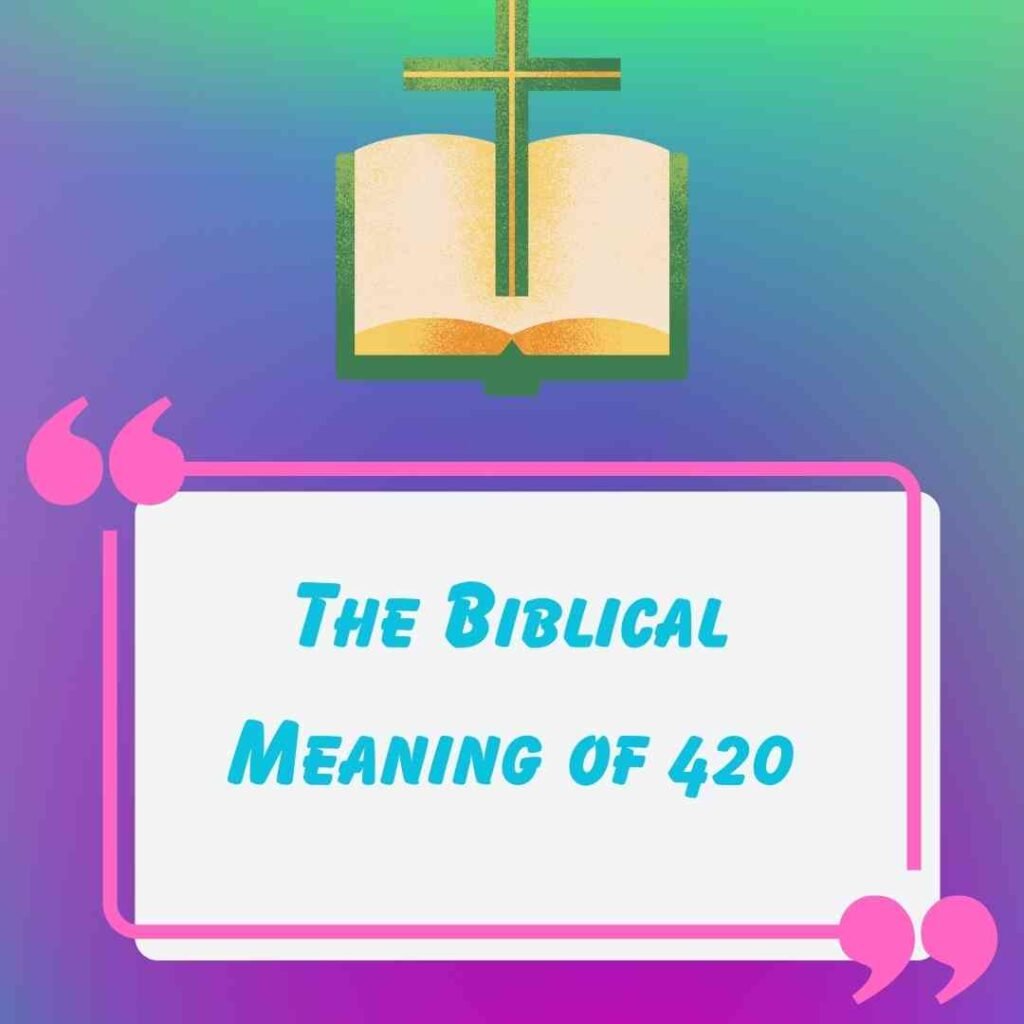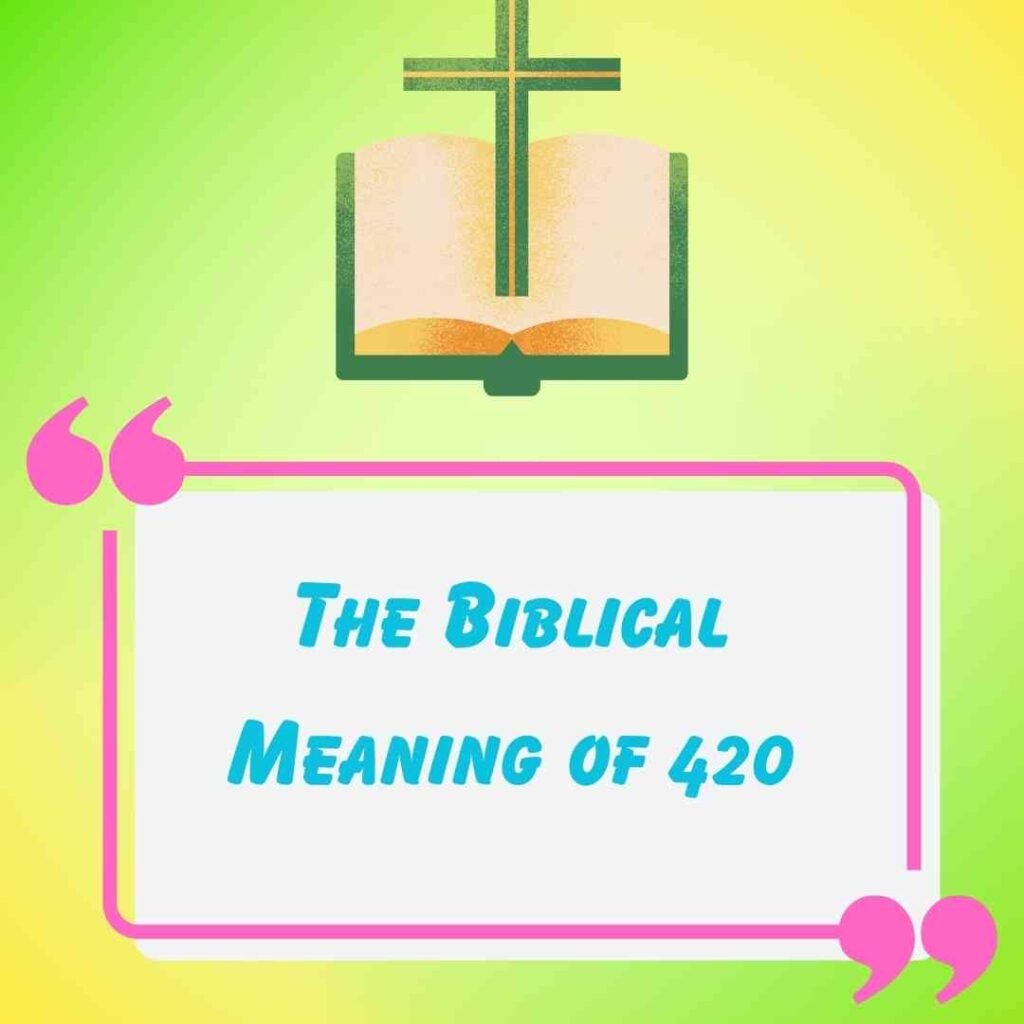The Biblical Meaning of 420: A Biblical Perspective
As you explore the domain of biblical numerology, you’ll discover that the number 420 holds a profound significance, echoing themes of spiritual growth, transformation, and redemption.
This numerical pattern is subtly woven throughout scripture, reflecting humanity’s journey towards divine alignment. But what exactly lies behind this enigmatic number?
Is it merely a coincidence that Solomon’s reign was blessed with 420 talents of gold, or is there a deeper meaning waiting to be uncovered?
You’re about to venture on a fascinating journey to unravel the mystery of 420, and what you’re about to discover will challenge your understanding of biblical history.
420 Biblical Meaning In a Nutshell

- In biblical history, 420 years represents the duration of the Israelites’ Egyptian sojourn, a transformative period of slavery and nation-building.
- The gift of 420 talents of gold to Solomon symbolizes his unprecedented prosperity and God’s blessing on his reign, securing peace and prosperity for Israel.
- The number 420 holds significance in biblical numerology, conveying spiritual truths and principles that reveal the Divine mathematics underlying creation.
- The intertestamental period, also known as the ‘silent years,’ spans approximately 420 years, setting the stage for the events of the New Testament.
- Biblical accounts, such as the four men in the furnace and Noah’s Ark, provide allegorical insights into the struggle between faith and oppression, and God’s judgment and mercy.
The Israelites’ Egyptian Sojourn
During their 400-year sojourn in Egypt, the Israelites experienced a profound transformation from a nomadic family group to a large, organized nation, setting the stage for their eventual exodus and receipt of the divine law.
As you explore into this pivotal period, you’ll discover how Egyptian slavery shaped the Israelite identity. Initially, the Israelites were welcomed into Egypt, but as their numbers grew, so did the Egyptians’ fear and resentment.
You’ll see how the Israelites’ forced labor and brutal treatment under Pharaoh’s rule forged a strong sense of community and solidarity among them. Despite the harsh conditions, the Israelites maintained their distinct cultural and religious practices, refusing to assimilate into Egyptian society.
This resilience in the face of oppression helped to solidify their identity as a chosen people, destined for freedom and self-governance. As you examine the Israelites’ Egyptian sojourn, you’ll gain insight into the complexities of their historical experience and the formation of their nationhood.

Four Men in the Furnace
As you plunge into the biblical account of Nebuchadnezzar‘s fiery furnace, you’ll encounter the courageous acts of four men – Shadrach, Meshach, Abednego, and Daniel – who boldly refused to worship the Babylonian king’s golden idol, sparking a dramatic showdown between faith and tyranny.
This pivotal event in Daniel 3 serves as a powerful allegory for the struggle between spiritual convictions and oppressive regimes.
The furnace, often symbolizing trials and persecutions, represents the intense heat of adversity that believers may face.
Yet, as you explore further into the narrative, you’ll discover the astonishing display of Divine protection, where the three Hebrew men miraculously emerge unscathed from the inferno.
This remarkable rescue not only testifies to God’s omnipotence but also underscores the theme of deliverance from oppression.
As you reflect on this ancient account, you’ll find solace in the promise of Divine protection, reminding you that even in the midst of fiery trials, faith can triumph over tyranny, and freedom can be secured through unwavering trust in the Almighty.
Noah’s Ark and the Flood
You’re invited to explore another pivotal biblical narrative, where God’s judgment and mercy converge in the epic story of Noah’s Ark and the Flood, a catastrophic event that reshapes humanity’s destiny.
This ancient tale has captivated scholars and theologians for centuries, sparking debates about its historicity and symbolism. The story of Noah’s Ark and the Flood not only resonates with biblical accounts but also finds echoes in Flood legends from diverse cultures, such as the Mesopotamian Epic of Gilgamesh and the Hindu myth of Manu.
Recent Ark discoveries, like the alleged finding of wooden remains in Turkey’s Mount Ararat, have further fueled the quest for historical evidence.
Yet, beyond the quest for physical proof, the narrative of Noah’s Ark and the Flood offers profound insights into the human condition. It highlights the consequences of sin and the redemptive power of obedience, as embodied by Noah’s faithfulness.
As you plumb into this iconic story, you’ll uncover a rich tapestry of themes, motifs, and symbolism that continue to inspire and challenge us today.

The Significance of Four Directions
Four cardinal directions – north, south, east, and west – feature prominently in the biblical narrative, often symbolizing spiritual and moral orientations that chart humanity’s journey towards redemption.
These directions aren’t just geographical coordinates, but carry cultural significance and spiritual weight.
In biblical times, the east represented the Garden of Eden, symbolizing innocence and purity. The west, on the other hand, represented the setting sun, often associated with darkness and sin.
The north and south directions held significance as well, with the north symbolizing spiritual alignment and the south representing earthly concerns.
These directions weren’t just physical, but spiritual and moral compasses that guided humanity’s journey.
As you plunge deeper into the biblical narrative, you’ll discover that these directions aren’t just static concepts, but dynamic symbols that evolve throughout the story, reflecting humanity’s growth and struggle towards redemption.
Solomon’s 420 Talents of Gold
In a remarkable display of wealth and power, Solomon receives 420 talents of gold, a staggering amount that underscores the king’s unprecedented prosperity and God’s blessing on his reign.
As you plunge into the biblical account, you’ll discover that this monumental gift is a badge of honor to Solomon’s wisdom and diplomatic prowess. The king’s ability to forge alliances and facilitate trade has yielded a treasure trove of golden offerings, swelling the royal treasury to unprecedented levels.
Diplomatic triumph: The 420 talents of gold symbolize the success of Solomon’s foreign policy, which has secured peace and prosperity for Israel.
Economic boom: The influx of gold has stimulated economic growth, creating a golden era of prosperity for the Israelites.
Divine blessing: The sheer scale of the gift underscores God’s favor and blessing on Solomon’s reign, confirming his divine mandate.
Royal legacy: The accumulation of wealth and power will ultimately contribute to the construction of the Temple, cementing Solomon’s legacy as a wise and benevolent ruler.
As you reflect on Solomon’s remarkable achievement, you’re reminded that true prosperity is rooted in wisdom, diplomacy, and faith.
The Four Gospels Unveiled
As Solomon’s accumulation of wealth and power serves as a legacy to his wisdom and divine favor, the New Covenant’s Four Gospels offer a distinct yet complementary narrative, one that shifts the focus from earthly kingdoms to the eternal reign of Jesus Christ.
You’re about to set out on a journey that harmonizes the four accounts of Matthew, Mark, Luke, and John.
Gospel harmony is vital to understanding the life, ministry, death, and resurrection of Jesus, as each Gospel writer presents a unique perspective.
By examining the Gospel chronology, you’ll notice that each writer builds upon the others, providing an exhaustive portrait of Jesus’ life.
You’ll discover that Matthew focuses on Jesus’ kingly authority, Mark highlights His servanthood, Luke emphasizes His humanity, and John underscores His divinity.
As you explore the Four Gospels, you’ll uncover a rich tapestry of Jesus’ teachings, miracles, and interactions, ultimately revealing the profound significance of His life, death, and resurrection.
420 Years of Biblical History
What do you suppose is the most significant challenge in traversing the vast expanse of biblical history, which spans thousands of years and multiple covenants?
As you explore into the biblical timeline, you’ll encounter a complex tapestry of events, figures, and themes that can be overwhelming to navigate.
One of the primary hurdles is reconciling the ancient chronology with modern historical records.
To better understand the years of biblical history, consider the following key aspects:
The Genesis account: The creation story sets the stage for the entire biblical narrative, providing a framework for understanding the nature of God and humanity.
The patriarchal period: The lives of Abraham, Isaac, and Jacob laid the foundation for the Israelite nation and established critical covenants with God, serving as a powerful evidence to their faith.
The kingdoms of Israel and Judah: The divided monarchy period saw the rise and fall of prophets, kings, and kingdoms, shaping the course of Israel’s history.
The intertestamental period: The silent years between the Old and New Testaments hold significant implications for understanding the arrival of Jesus Christ.
Unraveling the Mystery of Numbers
You’ve navigated the complexities of biblical history, and now you’re poised to unravel the mystery of numbers that permeates the scriptural narrative, where the significance of numerical patterns and codes holds the key to deciphering deeper meanings and symbolism.
As you explore into the world of biblical numerology, you’ll discover that numbers aren’t just random quantities, but rather, they convey spiritual truths and principles.
The Bible is replete with numerical patterns that reveal the Divine mathematics underlying creation.
For instance, the number seven, often associated with perfection and completion, is woven throughout the fabric of scripture, from the seven days of creation to the seven seals of Revelation.
Similarly, the number twelve, symbolizing completeness and divine government, is reflected in the twelve tribes of Israel, the twelve apostles, and the twelve gates of the New Jerusalem.
Frequently Asked Questions
What Is the Spiritual Significance of the Biblical Number Seven?
As you plunge into the mystique of seven, you’ll find it symbolizes divine completion, representing sacred cycles that govern the universe, echoing the harmonious rhythms of creation, and ultimately, revealing the intricate web of life’s deeper purpose.
Is the Bible’s Concept of Time Literal or Figurative?
You excavate into the nature of time, wondering if it’s literal or figurative. Outside of biblical context, you find that ancient cultures recognized time cycles, which the Chronos framework attempts to quantify, blurring the lines between literal and figurative understandings.
How Do Biblical Prophecies Relate to Modern World Events?
As you examine modern world events, you’ll notice eerie parallels between End Time Prophecies and Global Chaos, where catastrophic wars, economic collapse, and environmental disasters eerily mirror ancient predictions, forcing you to question: are we living in the final countdown?
What Is the Symbolic Meaning of Colors in Biblical Contexts?
As you explore into color symbolism, you’ll discover that the Divine Palette is a powerful tool for conveying meaning, with red symbolizing passion, blue representing wisdom, and green signifying growth, revealing a rich tapestry of symbolism that transcends cultural boundaries.
Can Biblical Principles Be Applied to Everyday Life Decisions?
As you navigate life’s complexities, you can make faithful decisions by embracing moral guidance from timeless principles, allowing you to approach everyday choices with clarity, conviction, and a strong sense of purpose, ultimately leading to a life of freedom and fulfillment.

Hi, I’m Aurelia Starfrost, your spiritual guide at InsightfulSpiritual.com. I love exploring ancient wisdom and modern practices to help you on your journey. With a focus on meditation and energy healing, I’m here to guide you to find solace within and discover your spiritual essence.







